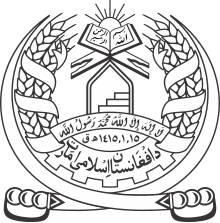"This Is the Home of the Brave" (Pashto: دا د باتورانو کور Dā də bātorāno kor) is a Pashto-language nasheed, currently used as the national anthem of the Islamic Emirate of Afghanistan. It is an a cappella song, meaning that it does not contain musical instruments, as instruments are considered haram by the ruling Taliban.[1] It is based on the communist-era song "Da De Azadi Khawra".[2]
| English: 'This Is the Home of the Brave' | |
|---|---|
| دا د باتورانو کور | |
 | |
National anthem of the Afghanistan under Taliban rule | |
| Adopted | 1996 |
| Readopted | 2021 |
| Relinquished | 2001 |
| Preceded by | "Fortress of Islam, Heart of Asia" (1996) National anthem of the Islamic Republic of Afghanistan (2021) |
| Succeeded by | "Fortress of Islam, Heart of Asia" (2001) |
The Islamic Emirate of Afghanistan (under Taliban rule) had formal laws specifying its flag and emblem; however, no anthem was specified.[3] This nasheed was commonly used in the opening credits of the broadcasts by Da Shariat Zhagh ('Voice of Sharia'), the Taliban's official radio station, since the late 1990s, when the group controlled most of the Afghanistan territory, as well as in the videos published by the Taliban's Commission of Cultural Affairs. It was also used during official ceremonies.[4][5][6][7] Due to that, it is considered to be the de facto national anthem of both the Taliban and the Islamic Emirate of Afghanistan.[8][9]
The recording most commonly used for this anthem features the voice of Mullah Faqir Muhammad Darwesh, a popular Taliban munshid.[10]
Lyrics
edit| Pashto original | Pashto Latin | IPA transcription[a] |
|---|---|---|
ساتو يې پۀ سرو وينو، دا د شهيدانو کور |
Sātu ye pə sro vino, dā də śahidāno kor |
[sɑ.tu je pə sɾo wi.no dɑ də ʃa.hi.dɑ.no koɾ] |
| Dari translation | English translation |
|---|---|
ما با خون خود از آن دفاع می کنیم، اینجا خانه شهداست |
We defend thee with our blood, this is the home of martyrs |
See also
editNotes
edit- ^ See Help:IPA/Pashto and Pashto phonology. The transcription is based on the Northern dialect.
References
edit- ^ Alexe, Theodor (9 April 2008). "Afghanistan: Sufi Brotherhoods Reemerge After the Fall of the Taliban". Radio Free Europe/Radio Liberty.
- ^ Da Di Azaadi Khawra - Abdullah Maquri, retrieved 19 June 2023
- ^ "Flag and Emblem Law of the Islamic Emirate of Afghanistan". Archived from the original on 3 June 2019. Retrieved 21 August 2021.
- ^ Afghan peace plans in limbo after opening of Taliban office, YouTube
- ^ Tharoor, Ishaan (19 June 2013). "The Taliban's Qatar Office: Are Prospects for Peace Already Doomed?". Time. ISSN 0040-781X. Retrieved 19 August 2021.
They cut a ribbon, played their anthem, hoisted the Taliban flag and signaled their readiness to meet for talks with foreign delegations.
- ^ "Q&A: Afghan Taliban open Doha office". BBC News. 18 June 2013. Retrieved 2 July 2024.
- ^ National Anthem of the Islamic Emirate of Afghanistan (Afghan TV), retrieved 29 May 2023
- ^ "BBCNazer.com | زندگى و آموزش | حرف های مردم: سرود ملی". www.bbc.co.uk. Retrieved 18 August 2021.
بعد از 5سال حکومت مجاهدين از هم پاشيد و حکومت طا لبان در افغانستان روی کار آمد، آنها با تغيير در ساير عرصه ها سرد ملی را تغيير دادند: ساتو يې په سرو وينو – دا د باتورانو کور...
- ^ Dr. Weyal, N. M. "د ملي سرود تاریخ | روهي". Rohi.Af (in Pashto). Retrieved 18 August 2021.
- ^ "ملا فقیر محمد درویش د جهادي ترنم منل شوی سرخیل". نن ټکی اسیا (in Pashto). 16 January 2018. Retrieved 18 August 2021.
د طالبانو د حاکمیت په مهال د شریعت غږ راډیو د نشراتي پروګرام پیلیدونکې ترانه هم د ده په انقلابی غږ کې ویل شوې: (ساتو یې په سرو وینو دا د شهیدانو کور..دا د باتورانو کور دا د باتورانو کور)